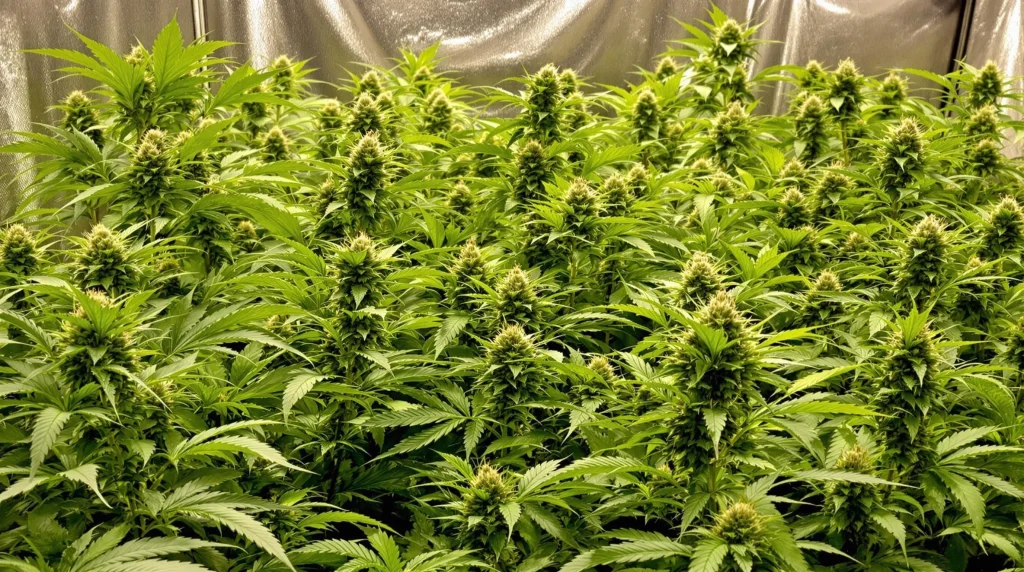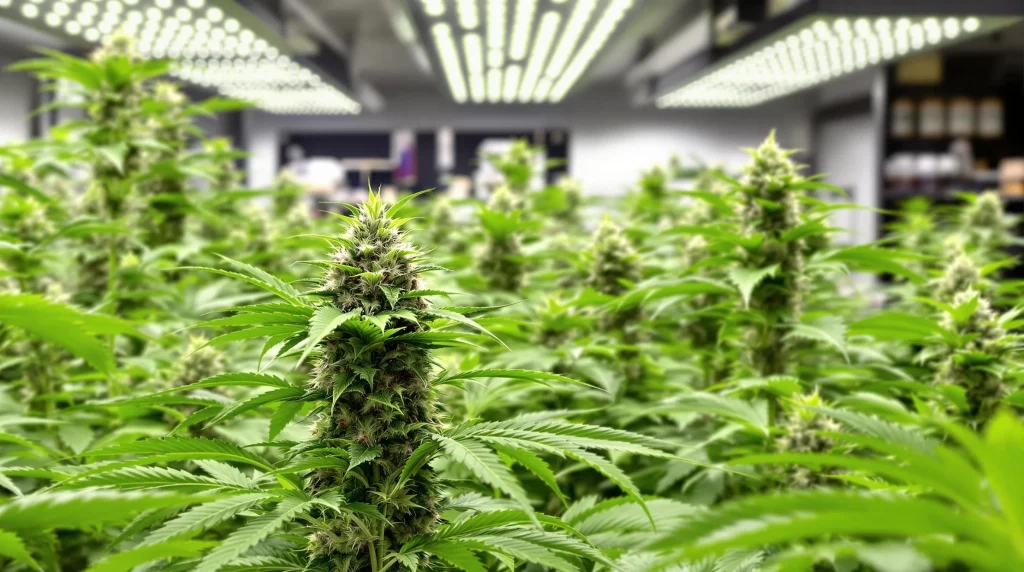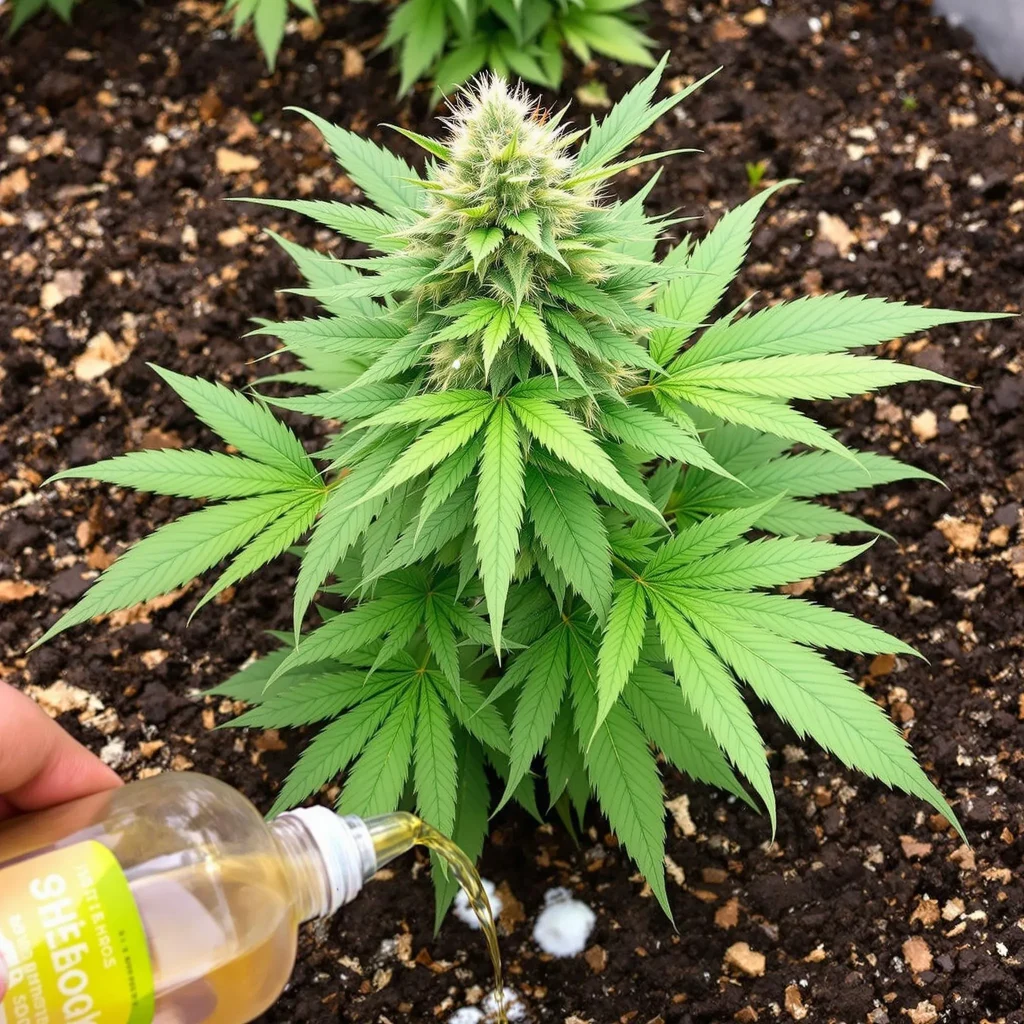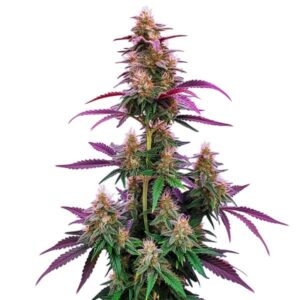Cannabis Fertilizer Needs
Nutrients in Cannabis Growth
Nutrients are the cornerstone of healthy cannabis plants. Cannabis requires three primary macronutrients: nitrogen (N), phosphorus (P), and potassium (K), collectively referred to as NPK. Each plays a distinct role, from promoting vegetative growth to enhancing flowering and yield. The best fertilizer for cannabis ensures these nutrients are well-balanced.
Nitrogen is essential for leafy, robust growth during the vegetative phase. Phosphorus boosts root development and flowering, while potassium strengthens the plant’s immune system and overall vigor. These nutrients must be balanced to avoid deficiencies or toxicities that can harm plant health.
Recommended Strains
Super Skunk Seeds
|
|
THC | 18% - 20% (Medium) |
|
|
Lineage | Skunk #1 x Afghan |
|
|
Type | Feminized |
|
|
Height | 6.56 ft | 2 m |
|
|
Yield | Medium |
|
|
Yield Indoor | 1.31 - 1.8 oz/ft² | 400 - 550 g/m² |
|
|
Flowering Time | 6 - 8 weeks |
|
|
Phenotype | 80% Indica / 20% Sativa |
|
|
Effects | Relaxed, Sleepy, Hungry |
|
|
Flavors | Skunk, Pungent, Earthy |
Fat Bastard Auto
|
|
THC | 30% - 38% (High) |
|
|
Lineage | Goldmember x Monkey Spunk x Ruderalis |
|
|
Type | Autoflowering |
|
|
Height | 4.92 ft | 1.5 m |
|
|
Yield | High |
|
|
Yield Indoor | 1.31 - 1.97 oz/ft² | 400 - 600 g/m² |
|
|
Yield Outdoor | 4.41 - 10.58 oz/plant | 125 - 300 g/plant |
|
|
Life Cycle | 8 - 10 weeks |
|
|
Phenotype | 50% Indica / 50% Sativa |
|
|
Medical | Anxiety, Fatigue, Migranes |
|
|
Effects | Euphoric, Powerful, Relaxed |
|
|
Flavors | Fruity, Skunk |
Primary Nutrients: NPK Explained
The NPK ratio on fertilizer labels indicates the percentage of nitrogen, phosphorus, and potassium in the mix. For example, a 10-20-10 fertilizer contains 10% nitrogen, 20% phosphorus, and 10% potassium. This ratio helps growers select the right fertilizer for each growth stage. During the vegetative stage, a fertilizer with a higher nitrogen content, such as 20-10-10, promotes rapid leaf and stem growth. In the flowering stage, a low-nitrogen, high-phosphorus fertilizer, like 10-20-20, encourages robust bud development. Knowing these ratios ensures optimal growth at every phase. This ratio helps growers select the right fertilizer for each growth stage to use the best fertilizer for cannabis.
Tailoring NPK ratios to specific strains further enhances results. Sativa-dominant strains may benefit from higher nitrogen during vegetative stages, while indica strains might require a balanced approach for dense flowering. Experimenting with ratios can refine the cultivation process over time.
Secondary Nutrients and Micronutrients
Secondary nutrients, including calcium, magnesium, and sulfur, play critical roles in cannabis health. Calcium strengthens cell walls, magnesium aids in photosynthesis, and sulfur contributes to protein synthesis. Micronutrients like iron, zinc, and manganese, though required in smaller quantities, are equally important for proper plant development. The best fertilizer for cannabis often includes these elements.
Deficiencies in these nutrients often manifest as discoloration, stunted growth, or leaf deformities. A well-rounded fertilizer or supplement tailored to cannabis ensures these trace elements are adequately supplied.
Types of Fertilizers for Cannabis
Organic Fertilizers: Benefits and Examples
Organic fertilizers are derived from natural sources like compost, bone meal, and guano. These fertilizers release nutrients slowly, promoting healthy soil microbiomes and reducing the risk of over-fertilization. They are often considered the best fertilizer for cannabis by organic growers.
Examples of organic fertilizers include worm castings, which improve soil structure, and fish emulsion, rich in nitrogen for vegetative growth. If you’re looking for effective organic amendments, check out this guide on Roots Organic Dry Amendments, which provides a natural way to enhance soil fertility and optimize nutrient uptake. Organic options are ideal for growers seeking sustainable and chemical-free cultivation practices.
Synthetic Fertilizers: Efficiency and Control
Synthetic fertilizers are chemically formulated to provide precise nutrient ratios. They offer fast-acting solutions for growers needing immediate results, particularly in hydroponic systems where soil health is not a factor. Products like liquid nutrient solutions are popular for their ease of use and measurable application. However, synthetic fertilizers require careful management to prevent nutrient burn and environmental runoff. When precision is critical, synthetic options might be the best fertilizer for cannabis.
The adaptability of synthetic fertilizers makes them a favorite among commercial growers. By tweaking formulations, cultivators can address specific deficiencies or optimize growth during critical phases. This flexibility ensures high yields and consistent quality.
Liquid vs. Granular Fertilizers: Pros and Cons
Liquid fertilizers are easy to mix and apply, making them suitable for hydroponics and drip irrigation systems. They provide immediate nutrient availability but may require frequent applications. Granular fertilizers, on the other hand, release nutrients slowly over time, reducing the need for frequent feeding. They are excellent for soil-based grows but may take longer to show results compared to liquid options.
Combining both types of fertilizers can offer the best of both worlds. Liquid feeds can address urgent needs, while granular options provide sustained nourishment, ensuring steady growth throughout the plant’s lifecycle. They provide immediate nutrient availability but may require frequent applications, making them a versatile choice as the best fertilizer for cannabis.
Best Fertilizers for Different Growth Stages
Fertilizer Requirements During the Vegetative Stage
The vegetative stage demands high nitrogen levels to fuel rapid leaf and stem growth. Fertilizers with an NPK ratio like 20-10-10 are ideal for this phase, ensuring lush greenery and strong structural support. In addition to nitrogen, secondary nutrients like magnesium and calcium are essential. These elements enhance photosynthesis and prevent issues like chlorosis, which can hinder plant health and productivity.
For outdoor grows, incorporating organic mulches or green manures can further enrich the soil. These additions improve water retention and nutrient availability, providing a stable environment for thriving plants.
Fertilizing for Maximum Yields in the Flowering Stage
During flowering, cannabis shifts its focus from vegetative growth to bud production. Fertilizers rich in phosphorus and potassium, such as 10-20-20, support this transition, enhancing flower density and resin production. Micronutrients like zinc and boron also play crucial roles in bud formation. Adding bloom boosters or flowering-specific fertilizers can significantly improve yield and quality.
Supplementing with natural enhancers like kelp or molasses during flowering boosts terpene production and resin content. These additives contribute to more flavorful and potent harvests, satisfying both recreational and medicinal users.
Transition Fertilizers: Supporting Growth Between Stages
As plants move from vegetative to flowering stages, transitional fertilizers help ease the shift. Balanced NPK ratios like 10-10-10 provide moderate levels of all essential nutrients, ensuring the plant adapts seamlessly. Gradual adjustments in feeding schedules prevent nutrient shock, maintaining steady growth and preparing the plant for peak performance during flowering.
Using slow-release fertilizers during transitions minimizes the risk of underfeeding. These products provide consistent nourishment, allowing growers to focus on other aspects of cultivation, like pruning or pest control.
Choosing the Right Fertilizer for Cannabis Strains
Indica vs. Sativa: Tailoring Fertilizer Needs
Indica strains, known for their compact structure, often require slightly less nitrogen than sativa strains during the vegetative stage. Sativas, with their tall, vigorous growth, benefit from nitrogen-rich fertilizers early on. Knowing the growth patterns of your strain allows for precise nutrient management, maximizing each plant’s potential.
Hybrid strains may demand a customized feeding approach. By observing their growth habits, growers can determine whether to lean towards indica or sativa nutrient profiles for optimal results.
Autoflowering Strains: Special Fertilizer Considerations
Autoflowering strains have shorter lifecycles, requiring carefully timed nutrient applications. Fertilizers with balanced NPK ratios, such as 10-10-10, ensure consistent feeding throughout their rapid growth phases. Avoid over-fertilizing autoflowers, as their compact size and quick transitions make them more susceptible to nutrient burn.
For beginners, premixed nutrient kits tailored to autoflowers simplify the process. These kits eliminate guesswork, ensuring plants receive the right nutrients at the right time.
Fertilizer Recommendations for High-Yield Strains
High-yield strains often demand robust feeding schedules. Products like bloom boosters or high-phosphorus fertilizers during flowering can amplify results, ensuring dense buds and resinous flowers. Combining these with supplements like potassium silicate enhances plant strength and stress resistance, further improving yield potential.
Incorporating microbial inoculants alongside fertilizers improves root health and nutrient absorption. These beneficial microbes break down organic matter, making nutrients more accessible to plants.
How to Use Fertilizers Effectively
Reading Fertilizer Labels: Decoding NPK Ratios
Knowing NPK ratios and other label details ensures accurate fertilizer application. Labels often include usage instructions tailored to different plant stages, helping growers avoid over- or under-feeding. Investing time in label interpretation maximizes the benefits of your chosen fertilizer, providing the right nutrients at the right time.
Additionally, tracking your plants’ response to specific fertilizers allows for adjustments. Keeping a cultivation journal helps identify patterns and refine feeding schedules over multiple grow cycles. This step is crucial when selecting the best fertilizer for cannabis.
Mixing and Applying Fertilizers Correctly
Always dilute fertilizers as per the manufacturer’s recommendations to prevent nutrient burn. Evenly distribute the solution across your plants, ensuring consistent feeding for all. Avoid applying fertilizers directly to dry soil, as this can harm roots. Water your plants lightly before feeding to minimize risks and enhance nutrient absorption.
Using drip irrigation systems simplifies fertilizer application, ensuring even distribution and reducing waste. These systems also save time, making them ideal for larger grow operations. Proper application techniques are essential for getting the most out of the best fertilizer for cannabis.
Timing Fertilizer Applications for Optimal Growth
Timing is critical in cannabis cultivation. Feed your plants during the early morning or late evening when temperatures are cooler, reducing evaporation and improving uptake. Regular feeding schedules aligned with growth phases ensure your plants receive nutrients when they need them most.
Frequent monitoring and minor adjustments to feeding times can optimize results. Environmental factors like humidity and temperature also influence nutrient uptake, requiring flexible scheduling.

Common Mistakes When Fertilizing Cannabis
Over-Fertilization and Nutrient Burn
Over-fertilizing is a common error that can lead to nutrient burn, characterized by yellowing or browning leaf tips. Stick to recommended dosages and monitor your plants closely for signs of overfeeding. Flushing your plants with plain water can help remove excess nutrients, restoring balance and preventing further damage. best fertilizer for cannabis prevents such issues.
Using EC meters to measure nutrient concentration helps prevent over-fertilization. These tools provide accurate readings, ensuring your feeding solution stays within safe limits.
Using Organic Amendments for Long-Term Soil Health
Organic amendments such as bone meal, bat guano, and kelp meal are excellent for enhancing soil fertility over time. These materials slowly release nutrients, ensuring your cannabis plants have a consistent supply throughout their growth cycle. Bone meal is rich in phosphorus, supporting robust flowering, while kelp meal provides micronutrients that improve plant resilience.
Incorporating these amendments into your soil mix during preparation ensures a balanced nutrient profile. Additionally, using them in conjunction with compost teas or other organic fertilizers can amplify their benefits, promoting healthy microbial activity in the soil.
Leveraging Mycorrhizal Fungi for Nutrient Uptake
Mycorrhizal fungi form symbiotic relationships with cannabis roots, extending their reach and enhancing nutrient absorption. These fungi are particularly effective in aiding phosphorus uptake, which is crucial for flowering.
Adding mycorrhizal inoculants to your soil or transplanting mix boosts root development and overall plant health. This strategy is especially beneficial in organic or low-fertilizer setups, as it maximizes the efficiency of available nutrients.
Choosing Fertilizers for Different Growing Mediums
Fertilizers for Soil-Based Grows
Soil-based systems benefit from fertilizers that enrich the soil’s organic matter. Products like composted manure or organic blends with slow-release nutrients are ideal for long-term feeding. Soil growers can also use granular fertilizers for convenience and sustained nutrient delivery.
For faster results, supplement with liquid fertilizers during peak growth stages. This dual approach ensures plants receive immediate nutrients while maintaining soil health over time.
Fertilizers for Hydroponic Systems
Hydroponic systems require water-soluble fertilizers specifically formulated for soilless environments. These fertilizers provide precise control over nutrient levels, ensuring optimal growth. Hydroponic setups often use a two-part or three-part fertilizer system to tailor nutrients for vegetative and flowering stages.
Regular monitoring of nutrient solution pH and electrical conductivity (EC) is crucial in hydroponics. Adjusting these parameters ensures nutrients remain bioavailable, preventing deficiencies or toxicities.
Fertilizers for Coco Coir
Coco coir is a popular growing medium that requires specific fertilizers to address its unique properties. Since coco tends to bind calcium and magnesium, adding supplements like cal-mag is essential. Fertilizers with balanced NPK ratios, along with micronutrient blends, support healthy growth in coco.
Frequent feeding is often necessary in coco coir systems due to its limited nutrient-holding capacity. Drip irrigation setups with liquid fertilizers can automate this process, ensuring consistent nutrition.
Tailoring Fertilizers to Environmental Conditions
Fertilizers for High-Temperature Climates
In hot climates, cannabis plants often require additional potassium to combat stress. Potassium enhances water regulation and improves heat tolerance, reducing the risk of wilting or nutrient lockout.
Using foliar sprays with potassium during heatwaves provides immediate relief. Pairing this with a soil mix rich in organic matter helps retain moisture, keeping roots cool and hydrated.
Fertilizers for Humid Environments
In humid conditions, soil tends to retain moisture longer, increasing the risk of over-fertilization. Opt for slow-release granular fertilizers that prevent nutrient buildup. Additionally, using silica-based supplements strengthens plant cell walls, making them more resistant to fungal diseases common in high humidity.
Maintaining proper airflow and monitoring soil moisture levels are essential in humid environments. This practice minimizes nutrient-related issues and ensures consistent growth.
Enhancing Flavor and Potency with Fertilizers
Terpenes in Flavor Development
Certain nutrients and supplements can boost terpene production, enhancing the flavor and aroma of cannabis. Sulfur, for instance, is a key element in synthesizing terpenes. Fertilizers rich in sulfur, along with magnesium and phosphorus, promote a robust terpene profile.
During the flowering stage, using organic fertilizers like fish bone meal or composted fruit peels can amplify natural flavors. Avoiding synthetic fertilizers in the final weeks ensures a clean, chemical-free taste.
Maximizing Cannabinoid Potency
Phosphorus and potassium play a pivotal role in enhancing cannabinoid production. High-phosphorus fertilizers used during late flowering stages encourage resin and trichome development, leading to more potent buds.
Adding supplements like humic acids or seaweed extracts can further improve potency by boosting nutrient absorption. Combining these with proper light intensity and environmental controls ensures optimal cannabinoid levels in the final harvest.
Advanced Techniques for Fertilizer Application
Split Dosing for Consistent Feeding
Split dosing involves dividing the recommended fertilizer dose into smaller, frequent applications. This technique minimizes the risk of nutrient burn and ensures a steady supply of nutrients. It’s particularly effective for hydroponic and coco coir systems, where nutrient uptake is rapid.
In soil-based systems, split dosing with organic fertilizers can improve microbial activity, enhancing overall soil health. Combining this with regular soil testing ensures precise nutrient management.
Using Bio-Stimulants for Enhanced Growth
Bio-stimulants like fulvic acid, amino acids, and microbial inoculants enhance nutrient uptake and stress tolerance. These products complement traditional fertilizers, improving plant resilience and boosting yields.
Applying bio-stimulants during critical growth phases, such as transplanting or flowering, maximizes their benefits. They are especially useful in organic systems, where nutrient availability relies heavily on soil microbial activity.

FAQs About Cannabis Fertilizers
What is the best fertilizer for indoor cannabis plants?
The best fertilizer for indoor cannabis plants depends on their growth stage. Nitrogen-rich fertilizers work well during vegetative growth, while phosphorus-heavy options are ideal for flowering. Indoor growers often prefer liquid fertilizers for their ease of application and precise control.
Can I use homemade fertilizers for cannabis?
Yes, homemade fertilizers like compost or banana peels can provide organic nutrients. However, they may lack the precise ratios needed for optimal growth. Combining homemade options with commercial fertilizers ensures balanced feeding.
How often should I fertilize my cannabis plants?
Fertilizer frequency depends on your plant’s needs and growth stage. During active growth phases, feeding every 1-2 weeks is common. Always monitor your plants for signs of over- or under-fertilization and adjust accordingly.














